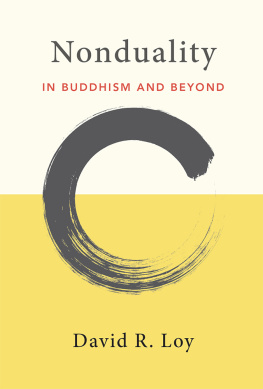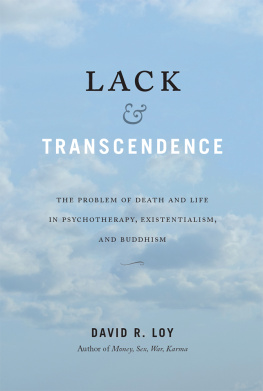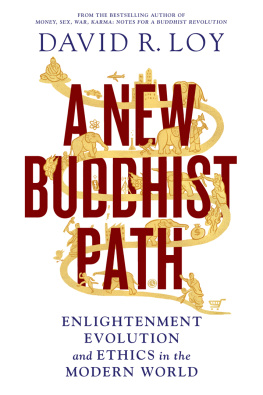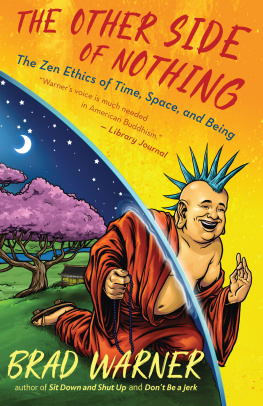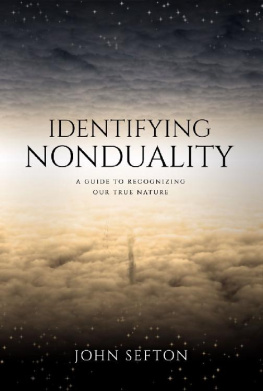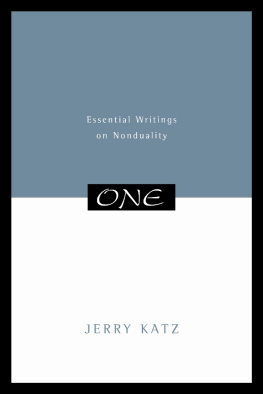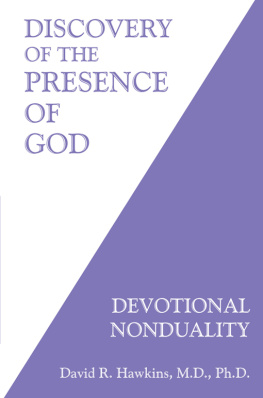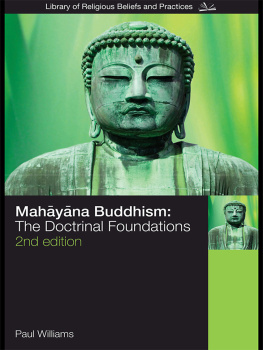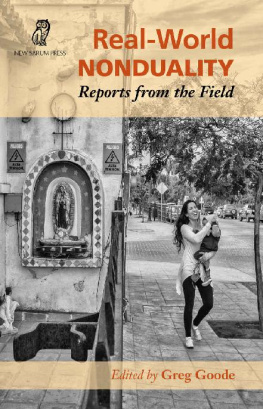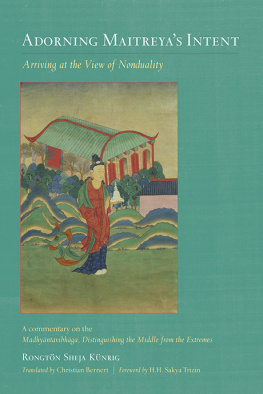PRAISE FOR NONDUALITY
David Loys Nonduality is a classic work in comparative philosophy exploring the similarities and differences between different forms of nondual thinking. A must-read for anyone interested in Asian philosophies.
Richard King, University of Kent
For anyone interested in nonduality, perhaps the central issue of the worlds wisdom traditions, there is no better resource than David Loys remarkably clear and comprehensive book.
Michael E. Zimmerman, University of Colorado at Boulder
On rare and precious occasions a book comes into ones life, and ones life is forever changed. The book you are holding in your hand carries this transformative potential, as does the rest of David Loys profoundly revealing body of work.
Will W. Adams, PhD, Duquesne University
A coherent and profound account of the underlying unity between what are ordinarily experienced as mutually exclusive oppositions: subject and object, perceiver and perceived, phenomena and the absolute. This is a brilliant book.
Jason M. Wirth, Seattle University
With fluid grace, David Loy engages one of the most central concepts of religious thought. Rendering the obscure clear and the abstract engaging, he offers intriguing parallels to Western texts. This is a book that I often return to, for it is a true companion for thinking of self in the world.
Jonathan Garb, Gershom Scholem Chair in Kabbalah, Hebrew University
A pioneering achievement from one of the leading voices in comparative philosophy and religion today. The book is a welcome antidote to the nihilism of our present age.
Kevin Aho, professor and chair of philosophy, Florida Gulf Coast University
David Loys masterpiece dispels misunderstandings and hazy generalizations, and lays out different kinds of nonduality with their respective implications for human thinking and living.
Ruben L. F. Habito, Perkins School of Theology, Southern Methodist University

Essential reading for anyone hoping to understand the thread that runs through all mystical traditions. It is a modern spiritual classic.
JAMES ISHMAEL FORD, author of Introduction to Koans
David Loys book is now the classic text on this topic and well worth patient, meditative reading.
DALE S. WRIGHT, author of The Six Perfections: Buddhism and the Cultivation of Character
A pioneering work and a must-read for everyone interested in Asian and comparative philosophy. Nonduality comprises the first systematic introduction in the English language to a multiplicity of nondual philosophical systems developed in South and East Asia. Loy explores alternatives to dualism with keen philosophical insight in a language that is clear, accessible, and engaging.
GEREON KOPF, professor and chair of religion at Luther College
David Loys thinking is always ahead of its time. Here, he shows complete mastery of nondual traditions from historical, philosophical, and experiential perspectives. This book offers a highly nuanced comparative analysis of nonduality in its primary settings of Advaita, Taoism, Zen, and other forms of Buddhism all while referencing Western philosophers such as Plotinus, Descartes, Kant, and Heidegger. Moreover, Loy advances his own thesis that there is a core experience of nonduality that can be sourced within different conceptual frameworks. No other single volume on nonduality offers the breadth and sophistication of Loys analysis.
PETER FENNER, author of Natural Awakening: An Advanced Guide for Sharing Nondual Awareness
Nonduality will teach you that you are not who you think you are you are much, much more than that.
WES NISKER, author of Essential Crazy Wisdom
To my parents, Robert and Irene Loy
Acknowledgments
My deepest debt of gratitude is to my Zen teachers, Yamada Kun-rshi, director of the Sanbo Kyodan in Kamakura, Japan, and Robert Aitken Gyun-rshi, director of the Diamond Sangha in Hawaii. Without their personal examples and Zen guidance, this work would never have come to be written. Yet neither is a philosopher: these ideas have not been discussed with them, nor have they read the manuscript. So they cannot be held responsible for the conceptual proliferations that follow.
An earlier draft of this book was my doctoral dissertation, submitted to the National University of Singapore in 1984, while I was teaching in its department of philosophy. I am grateful to S. Gopalan and Goh Swee Tiang for their comments on the first draft. Robert Stecker also offered helpful suggestions on some of the early chapters. I am particularly grateful to Peter Della Santina and other members of the informal Mdhyamika Study Group that met in 198384, where many of these ideas were first discussed. The publication of this book owes much to the efforts of two people: Jeanne Ferris, editor at Yale University Press, who encouraged and nurtured the project, and John Koller, professor at the Rensselaer Polytechnic Institute, whose criticisms were both supportive and extremely helpful.
Parts of this book were first published in various journals. Passages from chapters 2 and 3 were in The Difference between Sasra and Nirva, Philosophy East and West 33, no. 4 (October 1983): 35565, published by the University of Hawaii Press. An earlier version of the first section of chapter 3 appeared as Wei-wu-wei: Nondual Action in Philosophy East and West 35, no. 1 (January 1985): 7386, and an earlier version of the second section as Chapter One of the Tao T Ching: A New Interpretation in Religious Studies 21, no. 3 (September 1985), published by Cambridge University Press. Parts of chapter 4 appeared as Nondual Thinking in the Journal of Chinese Philosophy 13, no. 3 (September 1986). Some of the material in chapter 5 and the first two sections of chapter 6 was first presented as Enlightenment in Buddhism and Advaita Vedanta: Are Nirvana and Moksha the Same? in International PhilosophicalQuarterly 22, no. 1 (March 1982). An earlier version of the third section of chapter 6 appeared as The Mahyna Deconstruction of Time in Philosophy East and West 36, no. 1 (January 1986): 1323; much of the fourth section as The Paradox of Causality in Mdhyamika in International PhilosophicalQuarterly 25, no. 1 (March 1985); and an expanded version of the sixth section as The Clture of Deconstruction: A Mahyna Critique of Derrida in International PhilosophicalQuarterly 27, no. 1 (March 1987). Some of the ideas discussed in chapter 8 were first published as How Many Nondualities Are There? (the title now given to chapter 1) in the Journal of Indian Philosophy 11, no. 4 (December 1983). A few pages from chapter 6 and from the conclusion were presented to the third Kyoto Zen Symposium and appeared in Mu and Its Implications, Zen Buddhism Today 3 (1985), published by the Institute for Zen Studies, Kyoto, Japan.
I also thank Goh Boon Tay and Arlene Ho for their painstaking efforts in retyping various drafts, parts of which were barely legible, and Susan Hunston and Stephanie Jones for all their help with the manuscript.
Finally, deep and continuing gratitude to Linda Goodhew for taking care of me and putting up with me during this books long gestation.
Introduction to the Paperback Edition
This paperback edition provides an opportunity to reflect back on the gestation of this book as well as its reception: in the light of both, how might it be different if written today? The importance of the topic, and the vast literature touching on it, continues to dwarf any attempt to provide a comprehensive overview, but the perspective of a few years allows a better understanding of how tentative the following chapters are and how they might have been improved.

